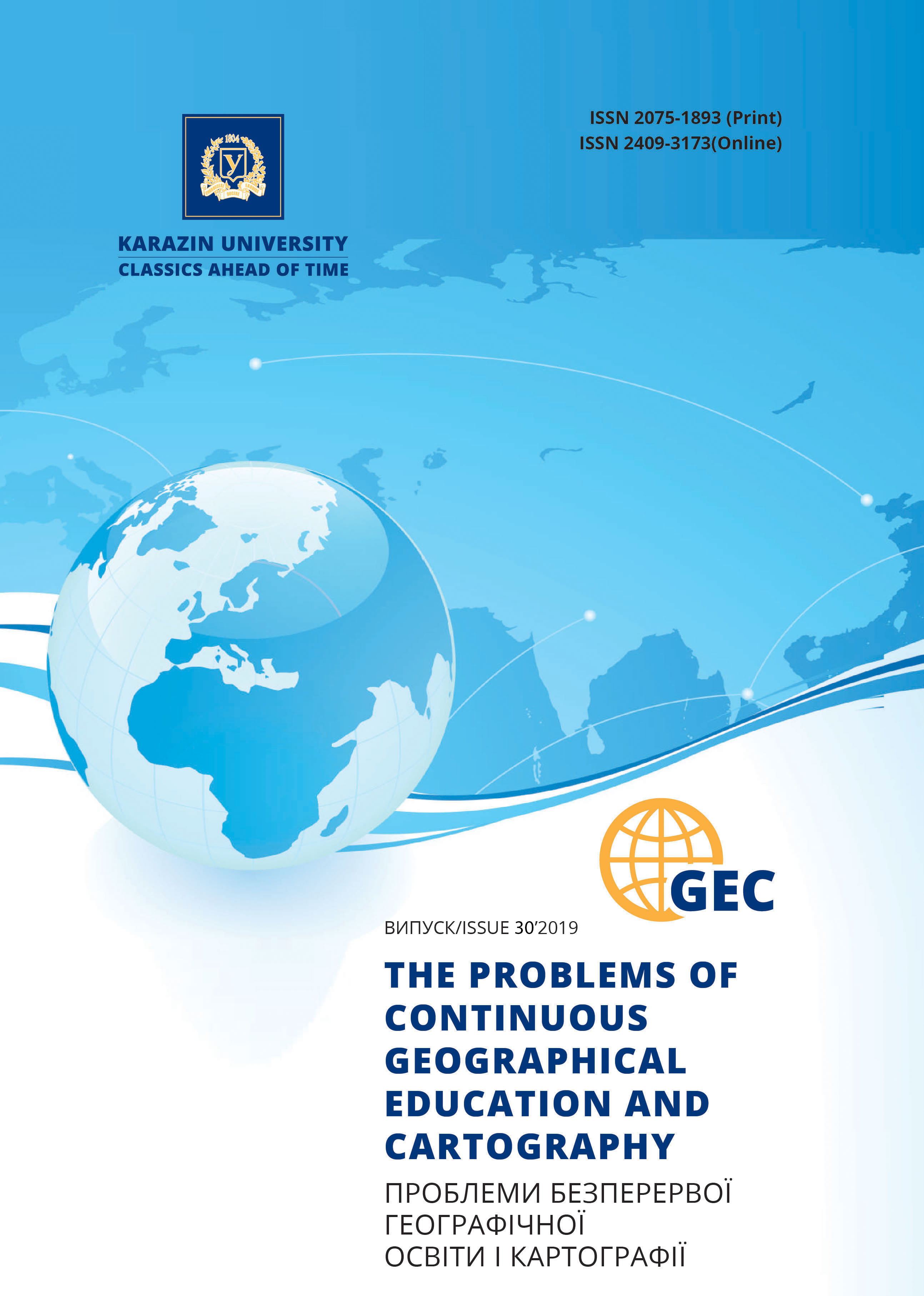Possibilities of GIS-technologies in implementing large-scale mapping during field practices of students-geographers
Abstract
Experimental results of remote satellite data processing with different resolution from 3 to 60 m of bands are discussed in the article.
The purpose of the article is to present and justify various options for using satellite imagery data and technologies of geographic information systems (GIS technologies) to solve various problems, taking into account previous research experience.
The main material. The author suggests using Sentinel-2 and PlanetScope to compile large-scale maps of territories of different sizes. Based on the improvement of the methodology (previously used by the author), it is proposed to distinguish plant groups as indicative objects of indicative contours using remote sensing data. The second reference object is the contours of water bodies. We propose using colors (RGB), shapes and roughness to identify the contours of objects, but given the actual material of the field outputs to key areas. These characteristics can indirectly determine geomorphology. Based on spectral characteristic images, we consider the seasons, vegetation periods, and territory. During the filed practice students process a data set for different periods and analyze this information to study landscape changes. Based on studies from 2015 to 2019, a database for landscape monitoring of the protected area is being formed. The author with students and other researchers have determined that it is necessary to separately analyze northern and southern parts of the Slobozhansky National Nature Park. QGis and ArcGis tools allow you to prepare data and do overlay analysis to compile a hypothesis map, and then the resulting map.
Conclusions and further research. It is established that the number of classes and the classification method depend on the properties of the objects of study. The best results were shown by isolating the contours of plant communities by the method of automatic classification by identifying key areas.
It has been experimentally established that the decoding of satellite images PlanetScope gives the best results in small areas. For decoding of a larger area, Sentinel-2 gives the best results, the thematic image data of which is more generalized. Based on the information received from thematic maps, we have attributive data on the topography, geological structure, soil for each contour. All information will be used for the landscape monitoring base in the Slobozhansky National Nature Park.
Downloads
References
Bajrak, G.R., Muxa, B.P. (2010). Dy`stancijni doslidzhennya Zemli: navchal`ny`j posibny`k [Remote study of the Earth: study guide]. L`viv: VCz LNU im. I. Franka, 712.
Bobra, T.V., Lychak, A.I. (2003). Landshaftnye osnovy territorial’nogo planirovanija: uchebnoe posobie [Landscape basics of territorial planning: a tutorial]. - Simferopol’: Tavrija-Pljus, 172.
Bogdanov, A.P., Aleshko, R.A. (2016). Razrabotka metodiki monitoringa sostojanija lesov na osnove ispol’zovanija dannyh mul’tispektral’noj kosmos”emki [Development of methods for monitoring the state of forests based on the use of multispectral space survey data]. - Arhangel’sk: FBU «Severnyj nauchno-issledovatel’skij institut lesnogo hozjajstva», 98-110.
Bodnya, O.V., Olijny`kov, I.A, Bary`shnikov, O.O., etc. (2015). Vy`kory`stannya mobil`ny`x GIS dlya landshaftny`x doslidzhen` pid chas prakty`k studentiv-geografiv. Zbirny`k materialiv konferenciyi «GIS-forum-2017» [The use of mobile GIS for landscape studies during the practices of geography students. Collection of conference materials «GIS-forum-2017»]. – Xarkiv: XNU im. V.N. Karazina, 1, 49-52.
Bodnya, O.V., Ovcharenko, A. Yu. (2018). Indy`katy`vny`j landshaftny`j monitory`ng nacional`ny`x pry`rodny`x parkiv (na pry`kladi tery`toriyi NPP «Clobozhans`ky`j») [Indicative landscape monitoring of national natural parks (on the example of the territory of NNP «Slobozhansky»)]. Bulletin of V.N. Karazin Kharkiv National University, 49, 192-207.
Bodnya, O.V., Ovcharenko, A.Yu., Sinna, O.I., etc. (2016). Landshaftne kartografuvannya NPP «Slobozhans`ky`j» zasobamy` mobil`ny`x, nastil`ny`x ta veb-dodatkiv ArcGis [Landscape mapping of NPP «Slobozhansky» by means of mobile, desktop and web applications ArcGis].The Problems of Continuous Geographical Education and Cartography, 23, 15-21.
Grodzy`ns`ky`j, M.D. (2017). Geografiya: stara nazva novoyi nauky` chy` vidrodzhennya majzhe zabutogo [Geography: the old name of a new science or the revival of an almost forgotten one]. Ukrainian Geographical Journal, 2, 65-68.
Perepechena, Ju.I., Glushenkov, O.I., Korsikov, R.S. (2017). Opredelenie lesistosti i kolichestvennyh harakteristik lesov po kosmicheskim snimkam Sentinel-2 (na primere Shebekinskogo municipal’nogo rajona Belgorodskoj obl.) [Determination of forest cover and quantitative characteristics of forests by Sentinel-2 satellite images (on the example of Shebekinsky municipal district of Belgorod region)]. Remote methods in forestry, 4, 85-93.
Romanchuk, I.F., Saxacz`ky`j, O.I., Apostolov, O.A. (2018). Ocinka vologosti g`runtu za dopomogoyu suputny`kovy`x znimkiv Sentinel-2 (na pry`kladi Bary`shivs`kogo poligonu Ky`yivs`koyi oblasti: dopovid` NAN Ukrayiny` [Assessment of soil moisture using satellite images Sentinel-2 (on the example of Baryshevsky landfill in Kiev region): The report ‘ of the NAS of Ukraine]. - Ky`yiv: DU «Naukovy`j centr aerokosmichny`x doslidzhen` Zemli Insty`tutu geologichny`x nauk NAN Ukrayiny`», 1, 60-66.
Chervan`ov, I.G., Zalyubovs`ka, O.V., Ovcharenko, A.Yu. (2019). Obg`runtuvannya vy`boru indy`katy`vny`x ob’yektiv dlya landshaftnogo monitory`ngu pry`rodooxoronnoyi tery`toriyi ta doslidzhennya yix za dany`my` dy`stancijnogo zonduvannya j pol`ovogo
znimannya [Justification of the choice of indicative objects for landscape monitoring of the nature protection territory and their research according to remote sensing and field survey]. Ukrainian Geographical Journal, 1, 15-23.
Hakan, A. (2017). Analysis of landscape changes as an indicator for environmental monitoring. Environmental Monitoring & Assessment, 189, 1-10.
Houet, T., Verburg, P., Loveland, T., etc. (2010). Monitoring and modelling landscape dynamics. Landscape Ecology, 25, 163-167.
Tretyakov, O.S., Bodnia, O.V., Balynska, M.O., etc. (2015). Features of interpretation of plant association of national natural park «Slobozhanskiy» using Landsat-8 satellite data // The Problems of Continuous Geographical Education and Cartography, 21, 73-79.
Walz, U. (2008). Monitoring of landscape change and functions in Saxony (Eastern Germany) – Methods and indicators. Ecological Indicators, 8, 807-817.
Watson, D., Doeer, V., Banks, S., etc. (2017). Monitoring ecological consequences of efforts to restore landscape-scale connectivity. Biological Conservation, 206, 201-209.
Copyright (c) 2019 Аліна Овчаренко

This work is licensed under a Creative Commons Attribution 4.0 International License.





